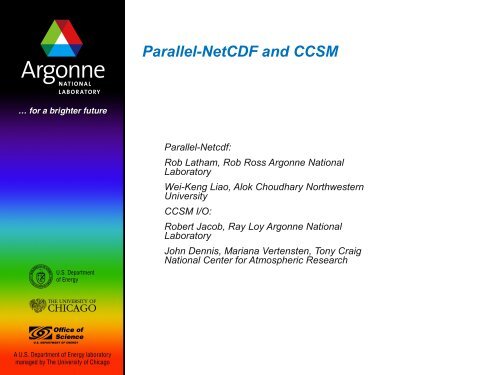Parallel-NetCDF and CCSM - SDM
Parallel-NetCDF and CCSM - SDM
Parallel-NetCDF and CCSM - SDM
- No tags were found...
You also want an ePaper? Increase the reach of your titles
YUMPU automatically turns print PDFs into web optimized ePapers that Google loves.
<strong>Parallel</strong>-<strong>NetCDF</strong> <strong>and</strong> <strong>CCSM</strong><strong>Parallel</strong>-Netcdf:Rob Latham, Rob Ross Argonne NationalLaboratoryWei-Keng Liao, Alok Choudhary NorthwesternUniversity<strong>CCSM</strong> I/O:Robert Jacob, Ray Loy Argonne NationalLaboratoryJohn Dennis, Mariana Vertensten, Tony CraigNational Center for Atmospheric Research
<strong>CCSM</strong> project <strong>CCSM</strong>: Community Climate SystemModel– model climate– simulate historical situations– predict future Four (mostly) independent components– atmosphere (CAM)– l<strong>and</strong> (CLM)– ocean (POP)– sea ice (CICE) NCAR-based; many lab, universitycollaborators– 100s of institutions– freely available One of the IPCC models– Nobel-prize winning!2
BGP Architecture Similar to BGL design with evolutionary improvements– 1024 Compute Nodes (CN) per rack– Each node: 4-core PPC 450 @ 850 MHz– 2 GB ram per CN I/O node forwards system calls Argonne “Intrepid” system (a target system for <strong>CCSM</strong> redesign)– 1 I/O node per 64 CN– 32k CN (128k cores) 512 MB per core:– 2x mem/core compared to BGL– staging all I/O on rank 0 (still) impossible!
<strong>CCSM</strong> redesign Old <strong>CCSM</strong>:– master coordinator process– all I/O from rank 0• this worked great on old Cray systems “Concurrent” vs. “Sequential”– concurrent:• each model component runs on a subset of processors– sequential:• components run one at a time• over all available processors New <strong>CCSM</strong>– less serialization– eliminate all global arrays– I/O from everyone• Create a new I/O library (PIO) for use by all components
Data layout Load balancing: domain split up into space filling curves– “cube the sphere”– weight regions by complexity– partition equal amounts of “work” Example: POP (ocean)– can ignore l<strong>and</strong>-only grids Decomposition has favorable impact on CPU scalability, less favorableimpact on I/O
<strong>Parallel</strong>-<strong>NetCDF</strong> Joint ANL-NWU project Based on original “Network Common Data Format” (netCDF) work fromUnidata– Derived from their source code Same Data Model as serial netCDF:– Collection of variables in single file– Typed, multidimensional array variables– Attributes on file <strong>and</strong> variables High Level Data Mode interface– traditional <strong>NetCDF</strong> access– vara (subarray), varm (mapping), vars (strided) Collective I/O Flexible Mode interface– Extends 'vara' 'varm' 'vars' accesses– User defines MPI datatype describing layout in memory
<strong>CCSM</strong> I/O <strong>and</strong> pnetcdf Application access pattern not exact fit for pnetcdf– SFC irregular shape doesn't match multidimensional array accesses– Can't use pnetcdf flexible mode: SFC regions cannot guaranteemonotonically non-decreasing MCT (model coupling toolkit)– re-arranges data from component layout into 1-D linear arrays– takes 1-D arrays <strong>and</strong> re-arranges into desired component layout PIO operations– Implements I/O in 1-D arrays– (optional) reduce I/O to “worker nodes”• similar to MPI-IO two-phase optimization– Supports I/O through pnetcdf, MPI-IO, <strong>and</strong> can fall back to serial netcdf
POP-IO Application I/O kernel written by John Dennis (dennis@ucar.edu) All climate/ocean science removed I/O same as full model component– e.g. keeps decomposition routines– measures I/O performance with <strong>and</strong> w/o rearrangement step– measures I/O performance with MPI-IO directly <strong>and</strong> with Pnetcdf Already been used in I/O study on BGL (Watson) hardware– excellent scalability up to 5k processes– performance “good enough” at 30k processes, but could be better– MPI-IO aggregation hints appear to be either ignored or make nodifference in perf
Why pnetcdf? climate/weather groups big users of <strong>NetCDF</strong> data sets– pnetcdf fully compatible with serial <strong>NetCDF</strong> file format no parallel I/O in <strong>NetCDF</strong>-3– one file per process• inefficient• untenable at 128k processes– forward all I/O to rank 0• impossible on BGL: not enough memory pnetcdf provides parallel I/O, common file format
Why not straight to file system? I/O software stack File system– aggregates storage devices MPI-IO:– collective I/O– lower-level but sophisticatedoptimizations High-level library:– better interfaces for applicationdevelopers• already thinking about interfacesclosely tailored to application needs– portable, self-describing– metadata (attributes)ApplicationHigh-level I/O LibraryI/O Middleware (MPI-IO)<strong>Parallel</strong> File SystemI/O Hardware
More information <strong>CCSM</strong>– http://www.ccsm.ucar.edu <strong>Parallel</strong>-<strong>NetCDF</strong>– http://www.mcs.anl.gov/parallel-netcdf PIO– http://swiki.ucar.edu/ccsm/93


